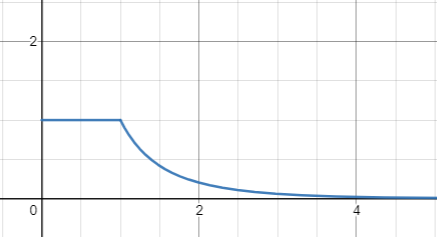Problem 5
Background: SIR model
- \(S(t)\): number of Susceptible people at time \(t\)
- \(I(t)\): number of Infected people at time \(t\)
- \(R(t)\): number of people who are Removed/Recovered because they've gained immunity
- Total population: \(N = S(t) + I(t) + R(t)\)
\(I(t)\)
\(S(t)\)
\(R(t)\)
a.
Explain the differential equation \[\frac{dS}{dt} = -bs(t) I(t)\] for the number of susceptibles
A: \(S(t+1) - S(t) \approx \frac{dS}{dt} = -bs(t) I(t) \)
Divide the above equation by \(N\) on both sides:
\[\frac{ds}{dt} = -bs(t) i(t) \]
since \(s(t) = S(t) / N\) and \(i(t) = I(t) / N\)
\(b\): number of contacts that each infected individual meets per day
a.
Explain the differential equation \[\frac{dr}{dt} = ki(t)\] for the fraction of recovered
A: \(R(t+1) - R(t) \approx \frac{dR}{dt} = kI(t) \)
Divide the above equation by \(N\) on both sides:
\[\frac{dr}{dt} = k i(t) \]
since \(r(t) = R(t) / N\)
\(k\): recovery rate
b.
Derive \(\displaystyle \frac{di}{dt}\) and explain
A: Given \(S(t) + I(t) + R(t) = N\) we have
\[s(t) + i(t) + r(t) = N / N = 1\]
\[\implies \frac{ds}{dt} + \frac{di}{dt} + \frac{dr}{dt} = 0\]
Substitute and obtain
\[\frac{di}{dt}=(bs(t)-k)i(t) \]
From a:
\(\frac{ds}{dt} = -bs(t) i(t)\)
\(\frac{dr}{dt} = ki(t) \)
c.
Is fixed population a good assumption for modeling COVID-19?
A: It depends.
- Deterministic view vs Probabilistic view
- Travel restrictions were lax during the early days of the spread
- Captures local spread but not between communities
d.
Under what condition does the \(i(t)\) curve attain its maximum?
A: By the chain rule, \[\frac{di}{dt} = \frac{di}{ds}\frac{ds}{dt} \implies \frac{di}{ds} = \frac{di}{dt}/\frac{ds}{dt}\]
From a & b:
\(\frac{ds}{dt} = -bs(t) i(t)\)
\(\frac{di}{dt} = (bs(t) -k)i(t) \)
- \(i''(s) \leq 0 \implies \) \(i\) is a concave function in \(s\)
- FOC: \(i'(s) = -1 + \frac{k}{c}\frac{1}{s} = 0\) tells us that maximum is reached when \(s = \frac{k}{b}\)
integrate
e.
Explain why \(\frac{b}{k} = \frac{\ln s_\infty}{s_\infty - 1}\). Plot \(s_\infty\) as a function of \(b/k\).
A: Consider \(t=0\) and \(t = \infty\) respectively.
Since \(s_0 \approx 1, i(0) \approx 0, i(s_\infty) = 0\), we get the equation
\[\frac{b}{k} = \frac{\ln s_\infty}{s_\infty - 1}\]
e.
Explain why \(\frac{b}{k} = \frac{\ln s_\infty}{s_\infty - 1}\). Plot \(s_\infty\) as a function of \(b/k\).
\(s_\infty\)
\(b/k\)
Recall that
\(s_\infty\) is upperbounded by 1

\(1\)
\(s_\infty\)
\(b/k\)
Recall that
\(s_\infty\) is upperbounded by 1

\(1\)
Networks-p5
By Sheng Long
Networks-p5
- 25



